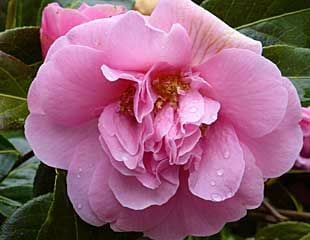
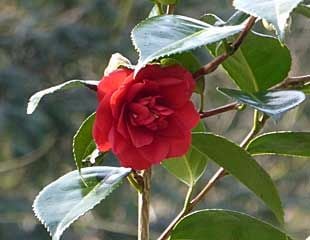
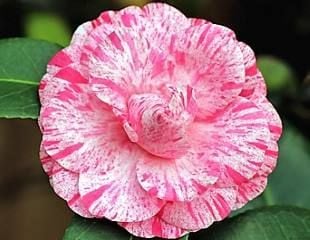
How to Grow Camellias
Camellia is an evergreen, spring flowering shrub with lovely, roselike flowers in a range of beautiful colours.
Camellias are not the easiest shrub to grow, and the saying "Right plant, right place" has resonance with Camellia. Camellia is not a shrub you can plant anywhere. It is essential to plant Camellias in correct the soil type, which is ericaceous (i.e. acid.) Camellias belong to the group of acid loving shrubs, which also includes Rhododendrons, Azaleas, Pieris, and many woodland shrubs which will only thrive in acid soil.
A common cause of Camellia failing to thrive is planting in the wrong soil. Don't know if your soil is acid? You can either buy a soil testing kit, or have a look around neighbouring gardens to see if they are growing any of the acid loving shrubs. If you don't have the right soil, you can grow Camellias in a container as long as you fill with ericaceous compost.
The hardiness of Camellia varies, ranging from fully hardy to slightly tender; the latter types require winter protection. Check the label for information and also an explanation of what frost hardy means.
Camellia size varies from 1-20 metre. Most offered for sale are medium-sized and slow growing up to a few metres. Camellias are evergreen, the foliage is attractive and glossy, which is an additional reason to include them in a mixed border. Camellias are spring flowering and are very attractive as the images show. Flowering colours are predominantly shades of red, pink, white and occasionally yellow. There are also many variegated Camellia, as illustrated above right.
Where to plant Camellia
Camellias are tricky to grow because they are fussy, and have a few "rules"
When planting, do not plant too deep, the root ball should be level with the earth.
Camellias must have acid soil, otherwise they will not thrive and flower. If your soil is not acid, you can only grow Camellia in a container, fortunately Camellia makes a good container shrub. Trying to change the pH of garden soil is not a good idea. It is essential to fill the container with ericaceous (acid) compost and feed only with ericaceous feed.
Camellias like moist, well-drained acid soil, in partial sun, (not full sun) and away from cold winds in a sheltered spot.
It is important not to plant camellias facing east, because the early morning sun can damage the blooms.
If you can water with rainwater, not tap water, which generally has too much calcium.
And as if that is not enough, Camellia will also benefit from a nice leaf mulch, being a woodland plant.
How to Plant Camellia
First and foremost, pick the right spot. Then dig a large hole and add leaf mould, if possible, or a suitable ericaceous compost and feed. Ensure that you plant the shrub at soil level. To check, once you have placed the Camellia in the hole, lie a cane across the top of the hole to check the shrub is at soil level, and then fill in and water well. The most important point is to plant in a suitable spot, sheltered with dappled shade and out of direct sunlight.
Camellia bloom damaged by frost and morning sun.
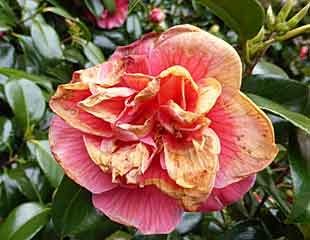
Although many Camellias are fully hardy, the buds and flowers are prone to damage caused by the morning sun and frosts. This is a common problem with Camellia. To avoid or reduce this problem, do not plant Camellia facing east where the blooms will catch the morning sun. This often occurs when there is frost followed by morning sun, which damages the buds and blooms, causing them to go brown as in the image left. It is the combination of early morning sun and frost, which does the most damage, and as a result many of the shrub's flowers can look similar to the one in the image.
So with Camellias, where in your garden you plant, is more important than with some other types of shrubs. A sheltered non east facing spot is best. As a woodland shrub, Camellia prefers semi- shade.
Problems when growing Camellia
The image below shows the two most common problems with Camellias: Unsightly browning of the blooms, and yellowing leaves. The most common cause of yellow leaves is that the soil is insufficiently acid. In which case either re plant in a container, or feed with ericaceous feed and don't use tap water. Wet and windy weather can turn the lovely blooms brown.
Another problem is that sometimes Camellias fail to flower. When this occurs, it is always worth trying an ericaceous feed in the spring and early summer. Flower drop can also be a problem if it is dry in the spring and summer, water well to prevent flower drop. A mulch will help to preserve moisture. It's best to avoid watering with tap water because it contains calcium, which reduces the acidity. It is important to feed Camellias only with ericaceous feed and early in the year.
In case you are struggling with growing Camellia, take heart from the image below. I took this at a very well known, prestigious garden and the shrubs are looking far from ideal. It's not as easy as it sometimes looks.

How to prune Camellia
Camellias do not need routine pruning. However, if a camellia outgrows its space, you can prune it, even severely if needed. As always, timing is important. Remember the buds on a Camellia form in summer and autumn. This means if you are to avoid cutting off the buds, you must prune just after flowering in the spring. There is no specific requirement to prune and they will happily carry on growing without it.
If a Camellia becomes overgrown, it can be hard pruned and will regrow. As with all renovative pruning, if you are pruning very hard, it may be best undertaken over 2/3 growing seasons. To carry out a renovating prune, cut back hard by about 1/3 to 1/2 in late winter or early spring. It follows the shrub will not flower, perhaps for the next couple of years. A lot of new growth will be thrown out. Thin out/prune again so that the shrub develops several sturdier branches to form the framework going forwards.
Having said all of that, once established in the right place, a Camellia will happily get on with the business of growing and flowering with little attention; the trick is to plant it in the right place and soil to start with.
Problems growing Camellia yellowing foliage
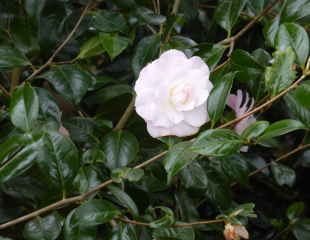
One of the common problems when growing Camellia is yellowing foliage.
The image left shows a healthy Camellia planted in the right place growing well with lovely glossy green leaves. The Camellia on the right is not enjoying the best conditions and its foliage is looking yellow and poor.
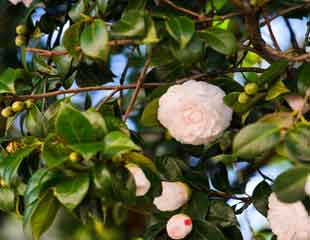
Growing Camellias in containers
If you like Camellias but your growing conditions are not ideal, you can grow Camellias in containers. To grow in a container, it may be more manageable to select a smaller variety and a good-sized container filled with ericaceous compost. Mix into the compost some ericaceous fertiliser, slow release for one season or feed with ericaceous feed. Water with rainwater. A camellia in a pot will require repotting into a large container with fresh ericaceous compost as it develops. If you do not repot top dress, which is to scrape away the top 5cms of compost from the top of the container and replenish with fresh ericaceous compost. In the winter elevate from the ground to protect from frost using bricks. Place in a sheltered spot away from direct sunlight.
Some suggestions for varieties of Camellia to grow
Camellia x williamsii 'Donation' large pink semi-double flowers which flowers from late winter to mid-spring; 5m x 2.5m, will grow in a shaded position and is more hardy than Camellia japonica 'Adolphe Audusson which has bright red flowers in early spring, 5m x 4m
Camellia 'Cornish Snow' small, white single flowers in late winter; 3m x 1.5m. H4 rating
Also : Camellia japonica 'Tricolor' which as the name suggests blooms are white, striped red and pink. C x williamsii 'Brigadoon' semi double rose pink blooms. C. Japonica 'Elegans' large rose pink flowers.
I rather like to bold red of C. 'Drama girl' illustrated below.
Camellia 'Easter Morn
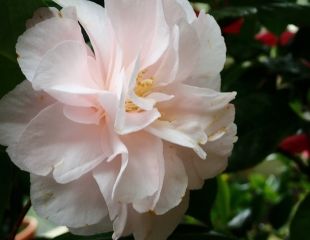
Camellia 'Drama girl
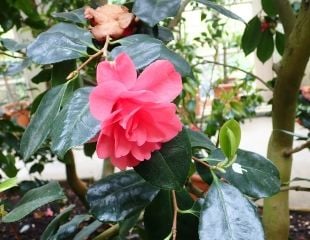
Cameilla 'E G Waterhouse'
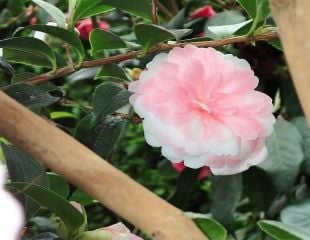

Camellia is a red wheelbarrow shrub, it is difficult to grow. Those gardeners whose Camellias flower year after year in abundance, with lovely green glossy leaves, are probably wondering why, but in many conditions and parts of the country, Camellia can be difficult. Travelling around, there are plenty of examples of Camellias with sad, yellowing leaves and discoloured blooms.
